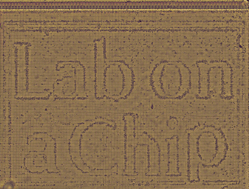We present an integrated circuit/microfluidic chip that traps and moves individual living biological cells and chemical droplets along programmable paths using dielectrophoresis (DEP). Our chip combines the biocompatibility of microfluidics with the programmability and complexity of integrated circuits (ICs). The chip is capable of simultaneously and independently controlling the location of thousands of dielectric objects, such as cells and chemical droplets. The chip consists of an array of 128 × 256 pixels, 11 × 11 µm2 in size, controlled by built-in SRAM memory; each pixel can be energized by a radio frequency (RF) voltage of up to 5 Vpp. The IC was built in a commercial foundry and the microfluidic chamber was fabricated on its top surface at Harvard. Using this hybrid chip, we have moved yeast and mammalian cells through a microfluidic chamber at speeds up to 30 µm sec–1. Thousands of cells can be individually trapped and simultaneously positioned in controlled patterns. The chip can trap and move pL droplets of water in oil, split one droplet into two, and mix two droplets into one. Our IC/microfluidic chip provides a versatile platform to trap and move large numbers of cells and fluid droplets individually for lab-on-a-chip applications.

You have access to this article
 Please wait while we load your content...
Something went wrong. Try again?
Please wait while we load your content...
Something went wrong. Try again?


 Please wait while we load your content...
Please wait while we load your content...